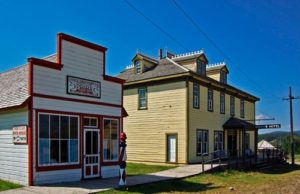Fort Steel is a small heritage town in the Kootenay region of BC. It is one of the best examples of a 19thC fort surrounded by a small settlement.
The town grew up round a ferry crossing over the Kootenay river. This was the only crossing within several hundred miles and there were high tariffs to cross the river. Gold was discovered and the town grew rapidly becoming a boom town by the 1890s. It became the commercial, social and administrative centre of the region, shipping lead, zinc and silver from Kimberley's North Star Mine to smelters in United States.
When the railway by passed the town in favour of Cranbrook, the town declined rapidly and became was a ghost town by the middle of the 20thC. In 1967 the provincial government designated Fort Steele as an historic site and restoration began. Most of the buildings seen today are original but a few are modern reconstructions.
The site is now a popular museum with costumed interpreters. It occupies a large site above the Kootenay River. It has retained part of the original street layout with original houses.
The Reception Centre has a small gift shop and leads into the town site.
The fort with the officers quarters and barns is on the left. Just down from it was the Government Building with the court room and jail. A high fence surrounded the exercise yard.
Across the road was the Wild Horse Theatre which has been restored as a working theatre. Actors were rehearsing the morning we visited.
The streets are arranged on a grid pattern and lined with small wooden shops and houses. Many had a small garden behind. The shops have all been fitted out as they would have been at the end of the 19thC with original wooden fittings. It was amazing the range of goods sold. The general store sold everything from dry goods to clothes and even sleds. They also provided a dress making service.
The town boasted a wide range of different shops including barbers, hardware, tinware, meat shop, bakers, sweet shop. There was a blacksmith, livery stables, customs office and the assay office. There was a doctor and dentist. There was a small one room school, several different churches and hotels.
Some of the buildings have been left in a falling down state. No doubt there would have been old buildings mouldering away at the height of the town’s prosperity.
There are family homes and small farms surrounded by gardens with flowers and vegetables.
Near the river is a large reconstruction of an overshot waterwheel which would have been used in the gold mines to drive the electric generator which worked the water pumps.
During the summer months there are steam trip rides from the nearby station and wagon rides around the site.
This was a worthwhile and interesting morning. The buildings have been beautifully restored and maintained. There is a sense of pride in the history of the town.
There is more information here: www.fortsteele.ca/
The pictures of our visit are here.
We visited during a five week trip to Canada. There is an overall report of the trip here.
I have written a series of detailed reports for some of the places visited for Silver Travel.








